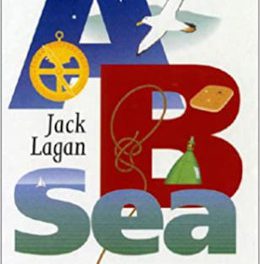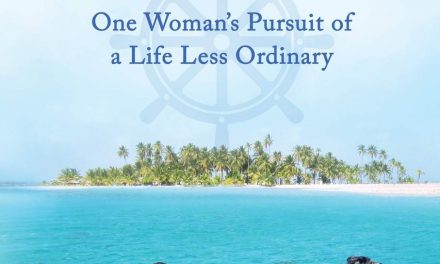A bluewater cruiser in a small package
Issue 152: Nov/Dec 2023
I was singlehanding on our Islander Bahama 30 on a spectacular fall afternoon, whitecaps dancing on the blue waters of Plumper Sound in the Canadian Gulf Islands, slowly gaining on a light blue sailboat on a converging course. I quickly identified the pretty boat as a Vancouver 27 and took a series of photographs of the beautiful scene. Through binoculars I caught the name, Ultima Thule, and called up the skipper on my VHF. We cordially exchanged email addresses and I promised to forward some of the photos I had taken. The moment soon passed, and we sailed on to our individual destinations.
Email exchanges with Renee Wissink, the skipper and proud custodian of Ultima Thule, soon led to a road trip to Pender Island to have a closer look.
 History
History
The Vancouver 27 was the first monohull from the drawing board of Robert Harris, a marine designer immersed in the world of multihulls in the early 1960s. He gained further experience with the design firm of Sparkman & Stephens before moving west to Vancouver, British Columbia, in 1972. Harris set up a small marine design practice and was commissioned to design a small oceangoing yacht for a local couple; that design became the Vancouver 27.
The wood boat was completed in 1972 and the owners sailed from Vancouver to New Zealand and back, proving the design a success. A mold was created and fiberglass production started. Over the ensuing 16 years, numerous local companies constructed the Vancouver 27, including Seair Marine in Vancouver and Philbrook’s Boatyard in Sidney. In subsequent years, other models in the Vancouver line followed, including a 25-foot double-ender, a 32-footer with or without a pilothouse, a 36, and a 42. However, the 27 was by far the most popular, with more than 250 made in Canada and England. By 1988, the Canadian molds were getting on in age and were destroyed that year in a fierce winter storm. Canadian production ceased.
European interest in the design came from Pheon Yachts Ltd. of Newhaven in the U.K., which obtained a license and launched its first Vancouver 27 in 1976. A few modifications were made during the U.K production. Adding 3 inches to the beam to provide more initial stability gave the hull a tumblehome appearance. Lengthening the deck aft of the cockpit created the Vancouver 28, and modifications to the cabin arrangements became the Vancouver 27F (for “family,” with a quarter berth). U.K. production continued when Pheon Yachts was bought by Northshore Shipyard, a company still producing sail and power yachts. The U.K. modifications did not cross the Atlantic, and Canadian production stayed true to the original design. U.K. production ended in 2007.

Ultima Thule heads upwind with
her high-cut headsail sheeted well above the lifelines.
Ultima Thule
Although not looking specifically for a Vancouver 27, Renee and his wife, Nikki, found Katepwa in Campbell River, a fishing and logging town on Vancouver Island’s east coast, in 2019. They learned that Katepwa had been sailed to the South Pacific and back by her original owners. There had been several intermediate owners before Renee and Nikki found her, purchasing the 1978 model soon after.
Interestingly, documentation shows that Katepwa was built by a single employee, Barrie Farrell, of Seair Marine in Vancouver in 1978. The only production employee of the company, Farrell constructed one boat at a time and built 12 Vancouver 27s before the company returned to building commercial fishing boats.
With proper regards to King Neptune, and with the eager assistance of grandchildren, Renee and Nikki changed their boat’s name to Ultima Thule, a loose translation from Greek and Latin mythology meaning “quest for adventure.” Necessary maintenance followed, with the repair of a few random bottom blisters and application of cobalt blue Concept DCC acrylic urethane topside paint. Installing a new diesel engine delayed the couple’s first summer on the water, but a cruise to the northern reaches of the Salish Sea and Desolation Sound followed.

Essential sail handling and ground tackle gear are all accommodated at the bow. Note the termination of the inner forestay.
Design and Construction
The Vancouver 27 was envisioned as an offshore cruising boat for a couple. The full keel incorporates a cutaway forefoot and a transom-hung rudder attached to the trailing edge of the keel — the epitome of a small, comfortable, long-distance cruiser. The narrow 8-foot 8-inch beam constricts interior space but provides for easy motion at sea. The cutter rig includes multiple sail options befitting an oceangoing boat.

Ultima Thule carries a life raft on deck, abaft the main cabin hatch.
The Vancouver 27 has a solid fiberglass hull with plenty of glass and resin, overbuilt by today’s standards. The deck is foam-, balsa-, or plywood-cored (depending on year and manufacturer) with appropriate hard points for deck fittings. The 4,600- pound lead keel is encapsulated in fiberglass and forms part of the hull structure — no keel bolts to worry about. The hull-to-deck joint is an inwardturning flange, with the deck set on top of a sealer, throughbolted, and then topped with the teak toerail. Renee reports a complete absence of water leaks in the area.
Deck and Rigging
Ultima Thule’s deck is original and looks to be in excellent condition after 45-plus years. No gelcoat stress fractures are evident.
The cockpit is small for a 28-foot boat, as should be expected on an oceangoing vessel on which storm waves could flood the footwell. The raised bridge deck, small companionway, and large scuppers minimize the chances of seas flooding the cabin. There is good back support, with foot bracing on the opposite seat, making for secure seating for a helmsperson, particularly when the boat is heeled. Unfortunately, the cockpit coamings are near vertical and not really conducive to long-term comfort.
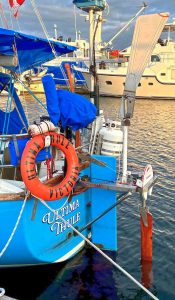
Ultima Thule is equipped with a self-steering wind-powered vane. Space is limited on a 27-foot boat, so in the absence of a ventilated locker, the propane tank is mounted to the stern pulpit.
All cockpit and deck fittings are of a high standard and oversized. The cabin has four portlights on each side, all fixed. Photographs of the original boats show what appear to be framed windows, probably in aluminum. On Ultima Thule the portlights are frameless acrylic nicely set into the fiberglass. There is a single large opening aluminum deck hatch just forward of the mast that floods the interior with light. For ventilation, the hatch is accompanied by three Dorade boxes adorning the cabin top, two in the main cabin with one directly over the galley and the third at the forward edge of the coach roof. Interestingly, the forward Dorade box has a split interior that allows air circulation in both the forward cabin and head.
The bow has a dual anchor platform leading to a manual windlass. This could easily be upgraded to a powered windlass, but Renee likes the simplicity and reliability of the manual. There is no deck access to an anchor locker, but dual hawsepipes run the chains to a substantial locker low in the bow.
The mast is a deck-stepped aluminum extrusion with single spreaders, supported by a compression post at the midships bulkhead belowdecks. On Ultima Thule the aluminum mast steps are welded in place to allow for rigging inspection (or watching for coral heads from the spreaders while entering a tropical lagoon). The standing rigging is stainless steel wire. The stays are inboard against the cabin trunk, allowing easy access along the sidedecks. With the stays inboard, the chainplates are secured to bulkheads below, with easy access for inspection. The entry point through the deck looks like it could be a troublesome spot for water intrusion. An inner forestay is permanently attached to the foredeck just aft of the hawsepipes, supported below by the anchor locker bulkhead. Running backstays, with adjustable tackle, are stored out of the way when not in use.
Working aft along the sidedeck, teak handrails along the cabin top offer secure handholds. On later model European versions, these are stainless steel. The cabin trunk steps up slightly to the sea hood covering the companionway hatch. A fabric dodger on Ultima Thule provides additional protection for the cockpit. And the cockpit is small! There is no other way to describe it. This is not your dockside party boat. But it was never designed to be. It’s perfect for two people, perhaps three in a pinch. There are two large scuppers at the stern of the footwell. The tiller is the ultimate in steering simplicity, with no complicated mechanisms to maintain and worry about. Hung over the stern, it also allows for an economical addition of a windvane steering system. The tiller does, however, intrude on usable space in the cockpit when underway, further reducing available room for crew.

The view forward from the main cabin shows berths port and starboard and the head in the forepeak.
Jib and staysail sheets are led through blocks mounted on a track atop the toerail to four cockpit winches, all of which are within easy reach of the helmsperson. Although sheeting angles could be tighter with inboard tracks, remember that this is a narrow boat with a full keel, not designed to win races to windward. The sheeting angles are appropriate. The mainsheet is off the end of the boom to blocks at either corner of the cockpit, completely out of the way and yet within easy reach.
Sails
Renee still has documents from the boatbuilder listing the original extensive sail inventory. Currently, Renee has a single main with two reefs, two high-cut jibs (100% and 120%), a staysail, and a storm jib. A spinnaker in a sock completes the inventory. The forestay has Harken roller furling, while the staysail is hanked on.
Mechanical
Construction literature indicates that most Vancouver 27s produced in Canada left the factory with a two-cylinder 12-hp Yanmar diesel engine; a Bukh 20 was also available. Renee deemed his Yanmar in debatable condition, and with plans for a future cruise up the Inside Passage to Alaska, reliability was important. A new 2YM15 Yanmar is now under the cockpit sole. Removing the companionway steps and, if necessary, the floor panel of the storage locker just above the engine, allows for unfettered access to all service points. Fuel and oil filters, along with the raw water pump and strainer, are all readily accessible at the front of the engine. Access to the back of the engine, through the large cockpit lockers, is problematic. A 26-gallon fiberglass fuel tank provides plenty of range.

the compact galley features a two-burner stove and oven, a small sink, and limited stowage.
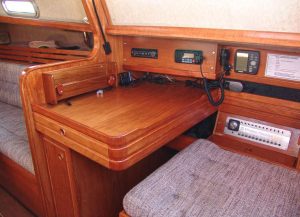
a small navigation station is located in the port quarter area, adjacent to the companionway
Accommodations
Heading through the narrow companionway and down four steps into a very deep cabin, I anticipated the cabin would be narrow, but wasn’t prepared for how long it appeared. Headroom is a good 6½ feet all the way forward to the head.
Immediately to starboard is a forward-facing nav station with a substantial chart table that has plenty of storage underneath. There is limited room for electronics, and Renee has fashioned a swing arm for the radar display, allowing for viewing from the helm. The seat swings up for access to a huge, well-insulated icebox next to the galley. The seat cushion can be removed to provide more counter space. A deep sink has both saltwater and freshwater original hand pumps. The single 26-gallon water tank is located under the cabin sole amidships. The Force 10 propane range is a recent addition, replacing the original diesel-fired range. Nikki was very pleased to not have to preheat the burners to boil water for a cup of coffee.

A small icebox is cleverly located underneath the nav seat.
On the starboard side of the main cabin is a long settee facing the galley. A small cabinet against the partial bulkhead supports a small dining table. You won’t be entertaining four for dinner at this table, which is removable and fits into a holder at the foot of the settee. At the aft end of the settee is a wet hanging locker and general storage area. There are multiple drawers tucked under the sidedecks above the seatback. The seatback folds up on a long hinge, increasing shoulder room when the settee is used as a berth. When the seatback cushion is removed, the surface becomes a massive plywood workspace running the length of the main cabin.
Moving forward through the partial bulkhead leads to the sleeping cabin with single berths to port and starboard. Although there is no door between the main and sleeping cabins, a privacy curtain could easily be installed. Against the starboard side of the bulkhead, Renee has mounted a propane-fueled Force 10 Cozy Cabin Heater, replacing the diesel-fueled heater that came with the boat. The two long berths have storage underneath and leecloths for security.

The head is in the forepeak, where headroom is limited, but it’s seamanlike for boys to also sit to pee.
Forward of the sleeping cabin is the head, with a manual toilet to port and vanity cabinet to starboard. A small holding tank sits against the chain locker bulkhead. Although exposed in Ultima Thule, the tank could easily be covered with a board to provide a countertop.
Underway
On the ferry ride to Ultima Thule’s home port of Port Browning on Pender Island, the weather forecast called for light winds and clear skies. It was going to be a perfect day. Upon arrival, however, the water was like glass and thick, low clouds and fog rolled in. So much for a test sail. Before I could return for a follow-up sail, Renee and Nikki headed north along the British Columbia coast on a two-year journey to Alaska. The performance portion of this review will rely on Renee’s opinion:
“Under power, the 2-cylinder Yanmar is surprisingly quiet. Ultima Thule moves nicely at about 2,500 rpm, making 5 knots at 1.5 liters per hour. With maximum continuous RPM of 3,600, the Yanmar can most certainly provide more speed should the need arise against current or wind.
“Its full-keel maneuverability under power or sail should not be compared to modern fin-keel and spaderudder configurations. But with careful planning and use of prop walk, the full keel can get into tight marinas and channels without incident.
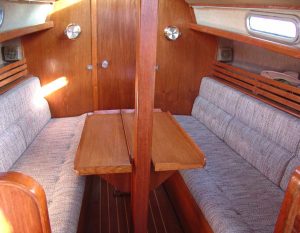
The settee to starboard, with stowage behind.
“Broad reaching is her strong suit under sail, but she also goes to windward well, although not quickly. Pointed into the wind and sea, her 27-foot length pounds somewhat, but it takes a lot of sea to get spray over the bow and rarely all the way back to the cockpit. Her happiest point of sail is a broad reach with 6-foot or better seas running. Then she settles into a comfortable motion, tracking without effort.”
Conclusion
While not a perfect design for coastal cruising in light winds, the Vancouver 27 is the ideal little boat for crossing oceans on a budget, with minimal crew. Designed for singlehanding or a cruising couple, she accomplishes that purpose with solid construction and comfort. Simplicity in maintenance and repair ensures that more time can be spent underway than in the boatyard. Kudos to Bob Harris for a design that performs as intended.
Thank you to Sailrite Enterprises, Inc., for providing free access to back issues of Good Old Boat through intellectual property rights. Sailrite.com



